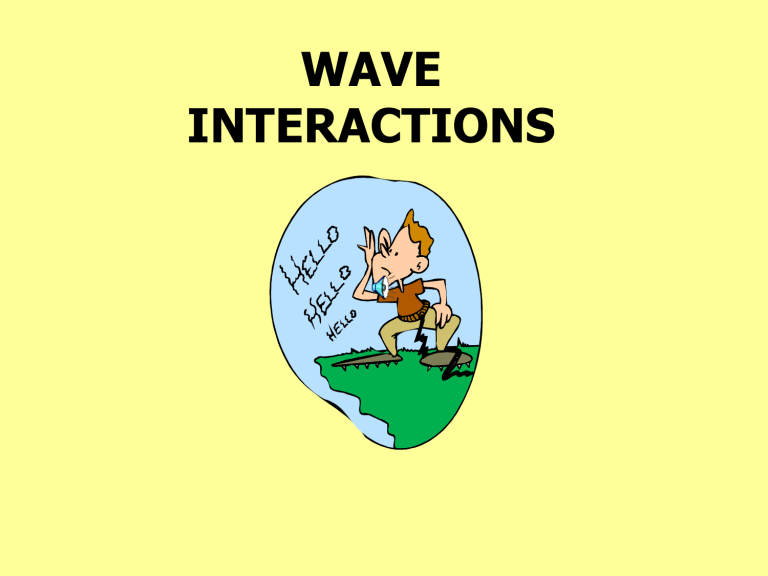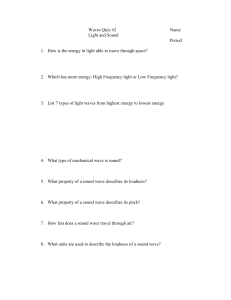
WAVE INTERACTIONS Longitudinal Wave wave particles vibrate back and forth along the path that the wave travels. Compressional Wave • Compressions The close together part of the wave • Rarefactions The spread-out parts of a wave Transverse waves • Crests Highest part of a wave • Troughs The low points of the wave Amplitudeis the maximum distance the particles in a wave vibrate from their rest positions. Frequency - the number of waves produced in a given time Waves transfer energy without transferring matter. Frequency= waves/time Wave Velocity - is the speed with which a wave crest passes by a particular point in space It is measured in meters/second. Wave Velocity = Frequency Wavelength Speed of Sound • Medium air (20 C) air (0 C) water (25 C) sea water diamond iron copper glass velocity m/sec 343 331 1493 1533 12000 5130 3560 5640 II. Properties of Sound Pitch - description of how high or low the sound seems to a person . Loudnesshow loud or soft a sound is perceived to be. Loudness of Sound in Decibels Sound Loudness (dbs) Hearing Damage Average Home 40-50 Loud Music 90-100 After long exposure Rock Concert 115-120 Progressive Jet Engine 120-170 Pain Ultrasound sound waves with frequencies above the normal human range of hearing. Sounds in the range from 20-100kHz - Infrasound - sounds with frequencies below the normal human range of hearing. Sounds in the 20-200 Hz range Interference • the result of two or more sound • waves overlapping Different sounds that you hear include (A) noise, (B) pure tones, and (C) musical notes. Standing sine wave patterns of air vibrating in a closed tube. Note the node at the closed end and the antinode at the open end. Only odd multiples of the fundamental are therefore possible. Standing waves in these open tubes have an antinode at the open end, where air is free to vibrate. Standing sine wave patterns of air vibrating in an open tube. Note that both ends have anitnodes. Any whole number of multiples of the fundamental are therefore possible. Doppler Effect is the apparent change in the frequency of a sound caused by the motion of either the listener or the source of the sound. Sounds from Moving Sources. A moving source of sound or a moving observer experiences an apparent shift of frequency called the Doppler Effect. If the source is moving as fast or faster than the speed of sound, the sound waves pile up into a shock wave called a sonic boom. A sonic boom sounds very much like the pressure wave from an explosion Supersonic Flight Resonance the frequency of sound waves exactly matches the natural frequency of an object. Water Waves Tsunami Wave length, 500 to 600 km in ocean Tsunami Warning • On December 26, they were playing in the sea when • • Tilly suddenly found the water was bubbling, like on top of a beer. She immediately realized tsunami was coming because the scene reminded her of a geography lesson about Hawaii's 1946 tsunami. Right away, Tilly told her parents, sister and other tourists to escape quickly, but at first they were in half belief. However, seeing Tilly's serious and firm expression, people started to be convinced of the seriousness of the thing and instantly left the beach. At last over 100 tourists were ended up in safety with no death http://www.phy.ntnu.edu.tw/java/propagation/propagation.html






